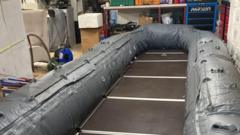
Science Corporation, a biotech startup launched by a Neuralink cofounder , claims that it's achieved a breakthrough in brain-computer interface technology that can help patients with severe vision loss. In preliminary clinical trials, legally blind patients who had lost their central vision received the company's retina implants, which restored their eyesight and even allowed them to read books and recognize faces, the startup announced last week. "To my knowledge, this is the first time that restoration of the ability to fluently read has ever been definitively shown in blind patients," CEO Max Hodak, who was president of Neuralink before founding Science Corp, said in a statement.
The device, called Prima, is a small, photovoltaic chip that's surgically implanted under the retina. It combines with a special pair of glasses with a built-in camera that projects visual data into the eye chip using invisible, near-infrared light. When the near-infrared rays hit the chip's photovoltaic arrays, it not only powers the device, but converts the transmitted data into electrical signals that stimulate the retinal neurons still remaining.
These get sent to the brain, and voilà: you have rudimentary eyesight. Science Corp bought the technology that powers Prima from another startup, Pixium Vision, earlier this year. Before the acquisition, the future of similarly functioning retinal implants looked uncertain , with promising companies in the space like Second Sight going belly up and leaving its blind patients quite literally in the dark .
Things are looking a little brighter now. In September, Neuralink received a "breakthrough device" designation from the Food and Drug Administration for its "Blindsight" brain implant, which Elon Musk claims — without evidence — will "enable even those who have lost both eyes and their optic nerve to see." It's likely years away from completing a clinical trial, however.
More substantively, Science Corp's latest clinical trial, the findings of which are yet to be published as a study, involved 38 patients suffering from geographic atrophy, a form of central vision loss caused by age-related macular degeneration, or AMD — the leading cause of visual impairment for older adults . All of them were given the Prima implants. The results varied, but were promising.
For some participants, they gained the ability to read strings of letters. Others could read lengthy portions of text from a book, and even fill in a crossword puzzle. On average, patients were able to see at an acuity of 20/160 after a year of participating in the trial — but five saw no improvements.
While Prima provides an edge over competitors by restoring "form vision" that allows patients to distinguish shapes, Hodak told Wired it doesn't provide images in color. Science Corp. also didn't specify how frequently patients had to use the zoom function to make text readable.
"It's a step forward for retinal prostheses, for sure. But there are some details we don't know that could tell us how big of a step it is," James Weiland, an ophthalmologist at the University of Michigan who was not involved in the research, told Wired . "And one of those details is whether the patients were using a magnified image when they recognized these letters.
" Those are important caveats, no doubt. But all things considered, the work remains encouraging. More on BCIs: Latest Patient Implanted With Neuralink Is Using It to Play "Counter-Strike 2" Share This Article.













